An electric bike battery is one of the most important parts to consider before buying an electric bike. It determines the power the bike can travel, the length of time the battery can go without recharging, and the weight of the bike.
So, knowing the electric bike battery types will enable you to pick the electric battery with a longer duration. There are various types of electric bike batteries. These are Lead-acid sealed batteries, nickel-cadmium batteries, lithium-ion batteries, nickel-metal hydride batteries, etc.
The earliest commercial electric bike of the 19th century used the Lead-acid battery, which was later replaced by the nickel-cadmium battery. Lately, new e-bike batteries are made with a lithium battery model.
Let’s discuss the top e-bike batteries and the crucial factors to consider when choosing an electric bike battery.
Types of Electric Bike Batteries
Knowing the basics of all battery packs involves understanding the properties and qualities of electric bike battery types.
The battery types below and their information will help you find a durable and high-quality battery.
1. The lead Acid e-bike battery (SLA)
The lead-acid battery was created in the 1800s. It is one of the earliest batteries, and its technology has proven durable over many decades. They are not expensive and are very easy to recycle. They are usually heavy with a weight of 30Ibs.
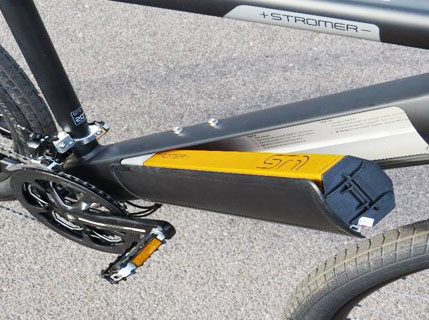
Lead-acid e-bike batteries have double the weight of nickel batteries and three times the weight of all lithium batteries. When considering using a lead-acid e-bike battery, ensure it comes sealed to prevent electrolyte leakages.
A lead-acid battery is also called an SLA battery. For an electric bike, the ideal battery to use is an SLA battery. A wet cell lead battery should never be considered because it is prone to leakage.
Regarding capacity, the nickel and lithium batteries are way higher than lead-acid batteries. The maximum capacity of lead-acid batteries is half that of lithium and nickel.
But the performance of the lead-acid battery is always improved based on the customer’s specifications.
Here is a video of a lead-acid e-bike battery for more information
2. Nickel-cadmium batteries (NiCd)
Capacity is one of the most important features of an e-bike battery. A nickel battery has more capacity per pound than a lead-acid battery. Nickel battery is costly.
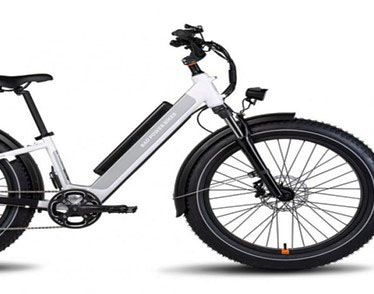
The cadmium in it makes it very hazardous and challenging to recycle.
The nickel battery was invented in 1899, with a terminal discharge voltage of 1.2Volts. Also, the highest electromotive force given by a nickel battery is 1.3Volts. When comparing the nickel battery to other batteries, the nickel battery has a good life cycle and performance at a low temperature.
Huge ventilated nickel batteries make emergency lighting, UPS (uninterrupted power supply), and standby power. If the nickel battery is fully charged without use in 24 hours, the battery charge drops by 70%.
With a maximum discharge rate of 1.8Amperes for an AA size battery and a discharge rate of 3.5 Amperes for a D size battery Nickel battery has a poor electricity density.
A fully charged Nickel-Cadmium battery has a positive plate made with nickel oxy-hydroxide (NiOOH) as an active material.
The negative plate cadmium metal has an electrolyte of potassium hydroxide (KOH) in water (20 to 35% by weight).
During discharge, NiOOH of the positive plate is transformed to Ni (OH) 2, while the cadmium metal of the negative plate is converted to Cd (OH)2.
Basic Charge and Discharge Reaction
For the overall reaction: 2NiOOH + Cd + 2H2O = 2NI (OH) 2 + Cd (OH)2
Charged = Discharged
3. Lithium-ion batteries (li-ion)
The lithium-ion battery is the most popular e-bike battery; new bikes usually come with it. It is enhanced for energy and total weight, giving you the best longevity and range.

Lithium-ion type of battery can be created into unique spaces or different shapes. This makes them have a high capacity and low power.
The lithium-ion battery is a rechargeable battery known for high power density in the electric bike battery types. It has four components in a lithium-ion cell: cathode, anode, nonaqueous electrolyte, and a separator. The cathode is an oxide (LiCoO2), while the anode is graphite.
The layer which separates the cathode from the anode is known as a porous polymer separator, consisting of polypropylene (PP) and polyethylene (PE).
Most consumers’ electronics come with lithium-ion batteries. They are popular rechargeable batteries used to build popular electronics.
They have the finest energy-to-weight quotient, least self-discharge rate, high unlocked circuit voltage, no memory result, and gradual loss of charge.
4. Nickel-Metal hydride batteries (NiMh)
This battery is more efficient compared to the nickel-cadmium battery, and it is very costly. They are easy to recycle, they don’t last long, they are difficult to maintain, and the charging process is a stressful task.
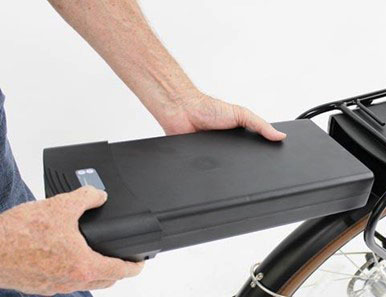
Nickel-metal hydride battery is rarely used because it causes high self-discharge and produces a lot of heat.
Each cell of the nickel-metal hydride battery has a value of 1.2V. The available battery package comes in 8.4, 7.2, 6.0, 4.8, 3.6, 2.4, and 1.2 volts. The concept behind this measurement is the chemical power difference between both electrodes.
When charging a nickel-metal hydride, a fast charger should be used to terminate its charge cycle to prevent overcharging. A good way to do this is to monitor the change of voltage with time.
The voltage across both terminals of the nickel-metal hydride reduces slightly when the battery is fully charged. The charger determines this and stops the charging process.
Below is a nickel-metal hydride battery charge curve.
5. Lithium Manganese Battery (Limg204)
Lithium manganese e-bike battery is the most recent of all lithium batteries. According to their manufacturers, they last longer than other lithium batteries and come with a good range. This battery type is also used by hybrid car brands, aside from e-bikes alone.
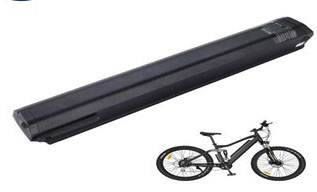
They come with manganese dioxide (MnO2) as a cathode. They operate using an intercalation/de-intercalation mechanism applicable to other commercial secondary batteries like lithium cobalt.
Any cathode based on manganese-oxide is usually non-toxic, earth-abundant, inexpensive, and generates better thermal stability.
The electrochemical cycling of lithium manganese produces this thermal stability.
6. Lithium Cobalt Battery (LCo)
This product has been in the marketplace for a while longer than lithium manganese batteries. But, the energy density is higher than that of other lithium batteries. However, it is light, reliable, and gives maximum power.
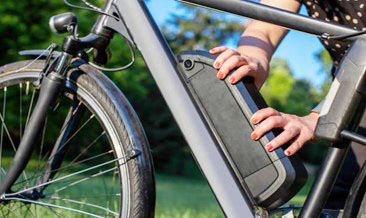
About 50% of the cobalt produced in the whole world goes for the production of lithium cobalt batteries. It has a very fast charging ability and an increased lifespan.
Lithium cobalt oxide found in nickel, manganese, sulfur, and arsenic ores are utilized in the intercalation electrode.
Lithium Cobalt oxide, otherwise known as lithium cobaltate, is used to produce laptops, phones, and cameras. This is because of its high capacity.
7. Lithium-ion Polymer Battery (LiPo)
Lithium-ion batteries started appearing in 1912 but became popular in 1991. This popularity came as a result of usage by huge companies.

Samsung was the initial company to use this product to produce lithium batteries. Its electrolyte consists of lithium-polymer instead of a liquid electrolyte.
This particular battery type accounts for above 90% of the e-bike batteries in the market. This is why it is known as the standard e-bike battery.
It’s cheap, rechargeable, and doesn’t discharge easily. With a high-density charge, they have a very long shelf-life.
Lithium-ion polymer battery has a high voltage, with a charging cycle of 300 to 400. When the battery is charged fully, the most common standard, Lithium-ion polymer batteries, can retain a charge of 4.2Volts per cell.
How Do I Choose an Electric Bike Battery?
To choose an electric bike battery, you must consider different factors, including voltage, battery dimension, battery attachment type, etc. They also include the battery shape, battery socket type, engine power, and battery capacity.
These considerations are only for “pedelec” ebike types. These are those electric bikes whose electric propeller gets activated by holding down the pedal.
The considerations do not apply to electric bikes with manual drive (cuff).
Voltage
A standard electric bike battery voltage usually ranges from 48Volts to 52Volts. The variation between these two voltages is based on their performance and power.
A higher voltage gives better productivity, just like a 52Volts battery will give a better performance compared to a 48Volts battery.
Here’s a guide to know the right power for your e-bike:
The Battery Dimensions, Attachment Type, and Shape
This answers the question of what our battery will look like and where on the bike it should be mounted. If we’re replacing a battery, then it is ideal for our new battery to have the same shape as the old one.
Here are different electric bike battery types based on how they are mounted:
Silverfish batteries:
This is the most used ebike battery. Its mounting process varies based on the type of bike. It can be mounted on the trunk or rear of the frame or held to the bottom of the bike.

Feature
- It has no pollution, and it is eco-friendly
- Resistant to fire and explosions
- It has an inbuilt BMS safety protection
- Its available capacity is 100%, and it has a very fast charging time
- Silverfish has 60% more energy plus safety protection for over-charging
- The battery has a longer life span than a lead-acid battery
Bottle Batteries:
This battery is similar to a silverfish battery in shape but not in the mounting process. It is usually used for creating a lightweight, lowkey “stealth” regeneration. It is enclosed in a very hard shell and recommended exclusively for 36Volts.
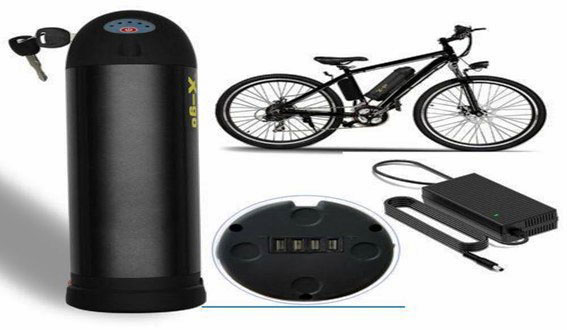
Features
- Lightweight and high water resistance because of the solid case.
- Fits the water bottle holder of the bike.
- Comes with a port plug charge barrel of DC5521 and a discharge cable adapter.
Down Tube Battery:
This is mounted the same way as a bottle battery. It fits the down tube of the electric bike’s frame. That is exactly why it is referred to as an in-tube battery. They fit the ebike frame perfectly, making it less visible. Its hard casing protects it from water.

Features
- Resistant to water because of its strong ABS (Acrylonitrile Butadiene Styrene) plastic case.
- High safety due to its inbuilt BMS (Battery Management System).
- Prevents over-discharge, over-charge, over-heat, short circuit, and over current.
- Its internal casing is stabilized by braces.
- Has a 4 LED power signal.
- Comes with a 5Volts USB output, which can charge phones, and other digital products.
Rear Rack Batteries:
This type of battery mounting is very usual with low-step bikes; it has easy access to remove and put back battery. The problem with this battery mounting is that people make mistakes in putting back the battery after removal. This can cause your battery to be removed from the hook and fall on the road.
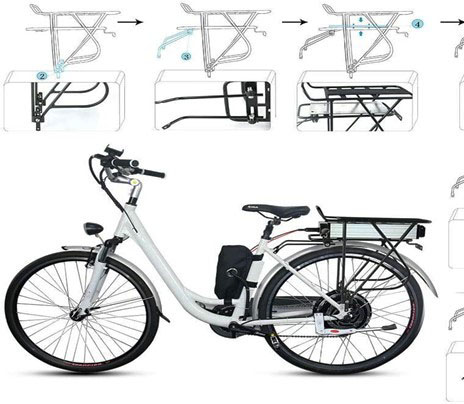
It is also expensive, with a replacement rear rack battery costing $800 and above.
Features
- Has a shrinkable casing for heat
- Its electric core is of a high quality
- Battery is shrink-wrapped with a waterproof glue
- Customizable battery shape
Battery Connector Types
There are two recommended connector series; one is Anderson Power poles for the high current connection. The second one is JST-SM connectors for the low current connection.
The advantage of using both connector series is that they can be installed with ease, and they allow voltage signals to be easily measured.
For more information on connector types, please watch this video
1. Anderson Powerpoles PP15/30/45 series
Anderson power products invented this connector in the 1960s. The product is not waterproof and doesn’t look as shiny as the newly molded connectors of nowadays.
Regardless of these qualities, this connector is still considered a genius design for 3 reasons:
- It is Genderless: This quality permits you to use the same plug as both source and load. Unlike other plugs, which have separate male and female plugs, Anderson connectors merge. Also, you won’t have to be confused to find which plug is positive and which is negative.
- It can be stacked with a dovetail joint: In making multiple connectors, the advantage of using the Anderson connector is that it has a dovetail slot.
So, a connector housing can easily be built by stacking multiple connectors with the aid of a dovetail joint.
- Connector contact & Separate Making: Anderson connectors have a smooth plug to prevent sparks when putting a battery connector into a motor controller. This spark spoils the metal contacts of both connectors.
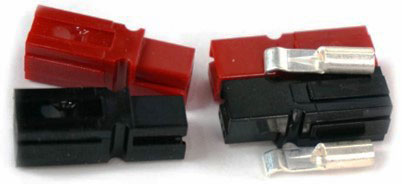
2. Anderson Connector’s Current Rating
All Anderson connectors are interchangeable and identical, despite the fact that they come in 45A, 30A, and 15A. The difference is the wire gauge for crimping pins; a heavy wire gauge handles more currents.
A current of 60A can house a 12g wire, but the connector begins to soften and melt when the current gets to 70A and above.
3. JST-SM Connector
This connector is ideal for small signals with a current of 2A. It ranges from 2 to 8 pins, making it very flexible for brakes, thermistors, throttle, hall sensor, PA (public address), and other e-bike systems.
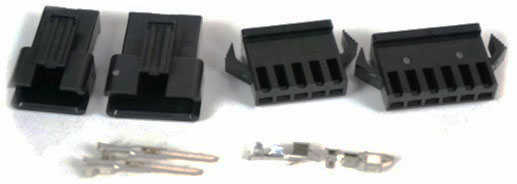
The main advantage of using this connector is that a probe can be put in it even while it is plugged in. The essence of this probe is to troubleshoot damaged signals.
The biggest disadvantage of using this connector is that it is not waterproof. This means the pins will corrode if it comes in contact with water extensively, especially for positive DC voltage pins.
Another advantage of using this connector is that if the pins corrode, they will still be very reliable and send good signals for years.
Battery Capacity
The capacity of the battery we need depends on the role the battery has to play in our electric bike. It also depends on the distance you want to cover with the bike.
If the terrain is mountainous with lots of hills, you need a very high-capacity battery.
Here is a chart showing the various battery capacities:
| 24V | ECO | TURBO |
| 8,8Ah – 11Ah | 25KM | 13,5KM |
| 11Ah – 14,5Ah | 32,5KM | 17,5KM |
| 14,5Ah – 17,4Ah | 38KM | 22,5KM |
| 17,4Ah – 20,3Ah | 45KM | 25KM |
| 20.4Ah – 23,2Ah | 55KM | 30KM |
| 23,2Ah – 27,2Ah | 65KM | 35KM |
| 36V | ECO | TURBO |
| 8,8Ah – 11Ah | 37,5KM | 22,5KM |
| 11Ah – 14,5Ah | 47,5KM | 30KM |
| 14,5Ah – 17,4Ah | 55KM | 35KM |
| 17,4Ah – 20,3Ah | 65KM | 40KM |
| 20,4Ah – 23,2Ah | 80KM | 47,5KM |
| 23,2Ah – 27,2Ah | 90KM | 55KM |
| 48V | ECO | TURBO |
| 8,8Ah – 11Ah | 45KM | 27,5KM |
| 11Ah – 14.5Ah | 67,5KM | 37,5KM |
| 14,5Ah – 17,4Ah | 80KM | 45KM |
| 17,4Ah – 20,3Ah | 95KM | 55KM |
| 20,4Ah – 23,2Ah | 110KM | 65KM |
The above table shows battery performance along with various voltages and capacities.
Another thing to consider is the e-bike riding modes, which come in Eco or Turbo. The distance covered by the turbo mode is usually greater than the eco mode. The e-bike engine does not always stay on turbo mode; it switches from eco to turbo.
The eco mode aids in saving energy, unlike the turbo mode, which consumes a large quantity of energy. The turbo mode increases acceleration to help conserve the energy of the user.
The table above shows the values for a 250watts powered electric battery.
Watch this video to know e-bike battery basics.
Frequently Asked Questions
Can I put a larger battery in my ebike?
Adding more battery cells to the battery packs could lead to charging problems. So it is ideal to buy a higher version of an electric bike with high battery capacity. That is, if you want a battery with higher capacity.
Will a bigger battery make my electric bike faster?
A higher voltage causes a faster motor speed, so increasing the voltage of your battery could help it move faster. Also, the motor should be checked to ensure it can withstand the upgraded voltage.
Carrying your battery charger with you to charge your e-bike whenever the battery gets low can help you move speed too.
Can I put a 52Volt battery on a 48Volts electric bike?
The 48Volts electric bike can very much use a 52Volts battery. Both batteries were designed to be interchanged. The LED light, the controller, motor, and software can use an interchanged battery between 48Volts to 52Volts.
Is a 48Volts better than 36Volts?
You can go faster with a 48Volts electric battery than you can go with a 36Volts electric battery. A 36Volts battery might cause muscle strain because it requires more effort to obtain the same speed as a 48Volts electric battery.
What is the difference between a 52Volts battery and a 48Volts battery?
A 52Volts battery gives a higher performance which entails higher speed than a 48volts battery. The battery life of a 52Volts battery is longer than that of a 48Volts battery.
This is the exact reason why a 36Volts battery can never be compared to a 48Volts battery.
How fast can a 48Volts electric bike go?
With a higher electric motor, the speed of your 48Volts electric bike battery, which travels at 20mph (32km/h), can be improved to from 28-30mph (45-48km/h). You need a motor with a higher rpm to make this happen.
Conclusion
With so many electric bike batteries out there, it is ideal to have a good knowledge of electric bike battery types. Examples include Lead-acid e-bike batteries, lithium-ion e-bike batteries, Nickel-cadmium e-bike batteries, and nickel-metal hydride e-bike batteries.
We recommend a lithium battery if you’re looking for the best e-bike battery. This is because of its high performance and its outstanding price. Also, its capacity and weight are the best of all the other e-bike batteries.
But before buying an electric bike battery, consider these factors, voltage, battery capacity, battery power, battery connector types, and battery dimensions. The knowledge will help you make the right pick.
